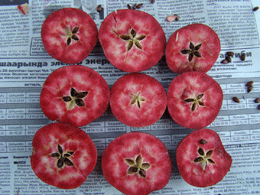Of course it is tiresome for you, Dear Reader, to have to wade through me correcting the mainstream media, but when duty calls I am powerless to refuse.
The BBC was all breathless a couple of days ago with news of a new apple variety on sale in England that has red flesh. Oooh. Ah. It’s like a tomato! And a large chunk of the little report was taken up by the breeder explaining that no GM was involved, just 15 years of crosses and selection and 20,000 seedlings rejected in favour of three that made the grade as worthwhile varieties. 1
 What really struck me, though, was not the utter imbecility of the reporter, or even what the bloody apple looked like. It was the fact that nobody had seemed to ask whether this was in fact the world’s first red-fleshed apple, as reported by FOXNews and The Daily Mail. 2 It isn’t that there are some wild red-fleshed apples out there, and this is the first one that’s good to eat. There have even been a fair number of commercial, good to eat, red-fleshed varieties. It’s just that reporters swallow rubbish so uncomplainingly. Google is your friend.
What really struck me, though, was not the utter imbecility of the reporter, or even what the bloody apple looked like. It was the fact that nobody had seemed to ask whether this was in fact the world’s first red-fleshed apple, as reported by FOXNews and The Daily Mail. 2 It isn’t that there are some wild red-fleshed apples out there, and this is the first one that’s good to eat. There have even been a fair number of commercial, good to eat, red-fleshed varieties. It’s just that reporters swallow rubbish so uncomplainingly. Google is your friend.
The photo (by Kayirkul Shalpykov, Bioresource, and lifted from the Living on Earth website) is of “Niedzwetzky apples (malus niedzwetzkyana), famous for their red flesh. There are 111 known trees left in the world”. Not sure I believe that either.
this is something unbelievable – lack of time? ignorance? or lazyness?
good at least that somebody spotted the mistake
I wish there was more info available about what genes were changed, nutritional qualities, etc. I am particularly intrigued to know what changes allow it to not brown. So little science :(
Did I miss where they said it wouldn’t brown? You can ignore all the nonsense about red apple pies …
Marketing groups and the press have much the same relationship with one another as politicians do.
Still these two apple varieties could actually be improvements over those that have already been propagated over the last several hundred years or more. I’ve eaten over a dozen red fleshed cultivars and the texture is lacking in all (the crispness is what is missing most often) and the flavors all lean toward the tart spectrum. Not a bad thing to some but the mass apple consumers like sweet based on looking at most in the grocery. Besides the fruit quality, they tend to carry cultural baggage for the fruit grower (hyper susceptible to diseases, real late ripening, poor storage ect). The fact that so many have never heard of red fleshed apples is because they haven’t been good enough to make it to the stores OR no one has successfully marketed them. Remember these are NEW variety introductions so it is not off base to call them new. I hope they are indeed an improvement as the health benefits of the increased antioxidant levels is a plus. Has anyone actually eaten either of these cultivars?
I don’t object to calling them “new”. I object to calling them “world’s first”.
And what about “pera cocomerina”, the red fleshed pear that is still cultivated in some farms of the Appenines, close to the source of the Tiber river? And what about the pink iranian apple cultivated near Bakran since a very long time?
i’ve grown some of these varieties. many have flesh which is tart and rather doughy.
however a few are good ……. hidden rose, weirouge and mott’s pink are good-flavoured, sweet and not too tart; pink pearmain is good when freshly picked; almata is ok straight off the tree; so is scarlet surprise. burford’s redflesh is poor; bitter and astringent; no-one can eat a whole one. devonshire quarrenden and discovery can be red fleshed in dull years – and there’s red devil, bred in the 70s by hugh ermen. these three all have good flavour; devonshire quarrenden probably the best. hall’s pink has a beautiful appearance, flavour and crispness when fresh.
there are lots of un-named red fleshed seedlings around if you look for them – flavours range from tasteless to average to very good. there are also old redfleshed trees in ancient orchards – take these to an apple identification day and the expert usually looks blank. the names of these seem to be lost.
some of the trees can be recognised by their leaves which have a red cast to them.
hidden rose is densely fleshed and keeps quite well – sometimes until late jan / early feb. most of the others mentioned above do not store for more than a week or two.